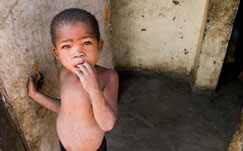Non-income poverty levels drop in democratic South Africa
18 March 2015
Poverty in a democratic South Africa declined significantly over the 18 years from
1993 to 2010, according to Prof Haroon Bhorat of the Development Policy Research
Unit in the University of Cape Town.
In a research paper for the Africa Growth Initiative of the Brookings Institution, the
American think tank, Bhorat and his colleagues, Ben Stanwix and Derek Yu, found
that this held true for virtually all households, regardless of the gender or race of
the household head, and whether it was in a rural or urban area.
The paper was released on 17 March, and is the 18th in the Africa Growth Initiative
Working Paper Series. The series, according to Brookings, "covers a broad range of
economic and development challenges facing Africa and provides high-quality,
African-led research on solutions that promote the continent's growth and
prosperity".
Bhorat's paper examined the changing nature of non-income welfare in
post-
apartheid South Africa, adding to other studies on poverty, which have focused
predominantly on changes in income welfare as the most important marker of
economic progress.
"Our paper is also an extension of the few studies that focus on non-income
welfare, which have generally not addressed the role of private assets in the
welfare calculation. We include public and private assets as well as educational
attainment in our [principal components analysis] approach to derive a non-income
welfare index," the researchers wrote in the conclusion to their paper.
Non-income poverty declines
Poverty declines were almost exclusively found for African-headed households,
which constituted almost the entire population of households living in poverty in
1993. "We also found that poverty declines were relatively more rapid for female-
headed households and in rural areas."
Over the 18 years, non-income poverty fell much more rapidly than
income
poverty, while the decreases in poverty "were relatively well targeted toward poor
households, and it was shown that in terms of both income and non-income
poverty, poorer households experienced the largest decreases in non-income
poverty".
The results were encouraging, the researchers said, although they pointed out that
the socio-economic situation at the end of apartheid must be kept in mind. At the
time, the majority of the non-white population lived in extreme poverty, in both
income and non-income terms. "The substantial progress that we observe has built
on an exceptionally low base of initial non-income welfare, and the levels of
poverty in South Africa, however one chooses to measure them, remain high."
A number of wide-ranging economic reforms were introduced in democratic South
Africa aimed at macroeconomic stability, economic growth, job creation and poverty
reduction. Provision of free basic services to previously disadvantaged
people, such
as water, electricity, sanitation and housing was a key policy objective, and socio-
economic rights such as housing, water and education were included in the
Constitution.
Most studies into the changes in the welfare of South Africans since 1994 have
looked at the private returns to economic growth, with the main focus on income-
or expenditure-based measures of well-being.
Money-metric measures
"Studies focused on these money-metric measures find that income poverty
worsened over the period between South Africa's transition to democracy until
about 2000 and 2001, and that since then a continuous but slow downward trend has
been observed," said Bhorat.
Very few studies had examined well-being in terms of access to assets and
services, yet this was an important component in understanding the extent to which
economic growth in South Africa had been inclusive, or pro-poor.
The World Bank defines poverty as
pronounced deprivation in well-being. It
comprises many dimensions, including low incomes and the inability to acquire the
basic goods and services necessary for survival with dignity. Poverty also
encompasses low levels of health and education, poor access to clean water and
sanitation, inadequate physical security, lack of voice, and insufficient capacity and
opportunity to better one's life.
Economic aspects of poverty focus on material needs, typically including the
necessities of daily living, such as food, clothing, shelter, or safe drinking water.
Poverty in this sense is a condition in which a person or community is lacking in the
basic needs for a minimum standard of well-being and life, particularly as a result
of a persistent lack of income.
"While the existing literature reveals increased delivery of basic services by the
government since 1994, there has been a fairly narrow focus on so-called public
assets, such as the state's provision
of housing, water and electricity," Bhorat and
his colleagues wrote in their paper.
"Most studies exclude information on private assets, such as whether a household
has a stove, a refrigerator, a television set, a vehicle and so on. We believe that
these are relevant indicators of economic welfare. In addition, most of the studies…
do not address the contribution that increased access to education makes to overall
well-being."
Using information on public and private assets, as well as on education, they
created a welfare measure to investigate shifts in non-income poverty between
1993 and 2010.
SAinfo reporter
 Poverty in Calitzdorp, Western Cape. (Image: Wikimedia Commons: Herman Pieters)
Poverty in Calitzdorp, Western Cape. (Image: Wikimedia Commons: Herman Pieters)




